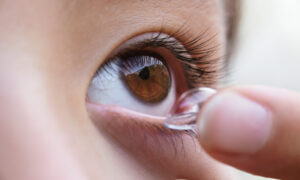May 8, 2024
LOS ALTOS, Calif. — SightGlass Vision presented four studies at the Association for Research in Vision and Ophthalmology (ARVO) meeting, detailing the latest data on its Diffusion Optics Technology (DOT 0.2) spectacle lenses for myopia management. This collective scientific body of knowledge deepens support for DOT spectacle lenses’ efficacy, safety, mechanism of action, and positive patient experience.
The company’s flagship myopia control intervention uses thousands of light-scattering elements to mimic more natural contrast on the retina — a unique mechanism of action to slow myopia progression in children.
Building on its long-term CYPRESS trial, SightGlass Vision initiated CATHAY — a two-year, randomized, controlled clinical trial of children ages 6 to 13 across five sites in China. Control of Myopia Using Diffusion Optics Technology (DOT) Spectacle Lenses in a Chinese Population (Laughton D, et al.) analyzes 71 participants at the six-month mark, indicating that DOT lenses substantially slowed myopia progression, as measured by cycloplegic spherical equivalent refraction (cSER) and axial length (AL), compared to the standard single vision spectacle lens control group.
AL increased from baseline by 0.19 mm (p <0.001) in the control compared to -0.05 mm (p=0.04) among DOT lens wearers. cSER increased from baseline by -0.38D (p<0.0001) among the control versus by 0.01D (p=0.85) with the DOT group. Unadjusted mean differences in the changes from baseline were significant: -0.23 mm for AL and 0.39D for cSER.
“The CATHAY interim results further validate the findings from our multi-year CYPRESS study, supporting the hypothesis that modulating retinal contrast can slow myopia progression in children from diverse populations,” said Debbie Laughton, BSc, PhD, Director of Medical Affairs for SightGlass Vision.
Short Term Effect of DOT Spectacle Lenses on Choroidal Thickness in Emmetropic Children (Jabeen A, et al.) illustrates the macula choroidal thickening (ChT) in children following short-term DOT spectacle lens wear, similar or greater to response from +3.00D spectacle lens use — a positive indication that contrast reduction favorably affects this uveal tract tissue. Conducted by the Centre for Ocular Research & Education (CORE), the research enrolled 30 children ages 8 to 14 in a two-visit, prospective, randomized, subject-masked crossover study.
Treatment Zone Visual Acuity with Myopia Control Spectacle Lenses (Rani R, et al.) profiles the immediate effect of Diffusion Optics Technology (DOT), Defocus Incorporated Multiple Segments (DIMS), and Highly Aspherical Lenslets (HAL) interventions on high- and low-contrast foveal visual acuity (VA). Investigators from Aston University’s Optometry & Vision Science Research Group enrolled 20 myopia adults in the prospective, single-visit, double-blind, four-way randomized crossover study to compare the technologies to single vision plano spectacle lenses. All three myopia management technologies performed well against the single vision lens, with DOT lenses providing superior VA in the peripheral treatment zone.
Aston researchers are also presenting findings from The Short-Term Effects of Spectacle-Based Myopia Management Interventions on Dynamic Vision (Davis L, et al.), which used the same group of participants. Dynamic vision when wearing DOT, DIMS, or HAL spectacle lenses was noted as good and generally similar to the single vision control.
“Our scientific program at ARVO 2024 adds to the substantial evidence supporting the myopia control efficacy of Diffusion Optics Technology, as well as guiding eye care professionals on making more informed choices regarding spectacle lens interventions. We are enthusiastic about how DOT lenses have been received in multiple countries and remain excited by the prospect of reaching even more children around the world,” said Andrew Sedgwick, CEO of SightGlass Vision.
SightGlass Vision’s patent-protected technology with clinically proven efficacy1-4 has made its commercial debut in several markets, including China, the Netherlands, and Israel, as well as through preliminary market trials in other countries. It is not yet available in the United States. The company operates as a joint venture of CooperCompanies and EssilorLuxottica.
References
1 Chalberg T., et al. Control of Myopia Using Diffusion Optics Spectacle Lenses: Efficacy and Safety Study (CYPRESS) 42-month results. ARVO 2023 Annual Meeting presentation. 27 April 2023.
2 Rappon J., et al. Control of myopia using Diffusion Optics Technology spectacle lenses: 12-month results of a randomised controlled, efficacy and safety study (CYPRESS). British Journal of Ophthalmology Published Online First: 01 September 2022. DOI: 10.1136/bjo-2021-321005
3 Rappon J., et al. Two-year effectiveness of a novel myopia management spectacle lens with full-time WEARERS. Invest. Ophthalmol. Vis. Sci. 2022;63(7):408.
4 Laughton, D et al. Safety and Efficacy of a Novel Spectacle Lens for Myopia Control Over Three Years. 2022 American Academy of Optometry annual meeting. 27 Oct 2022.














